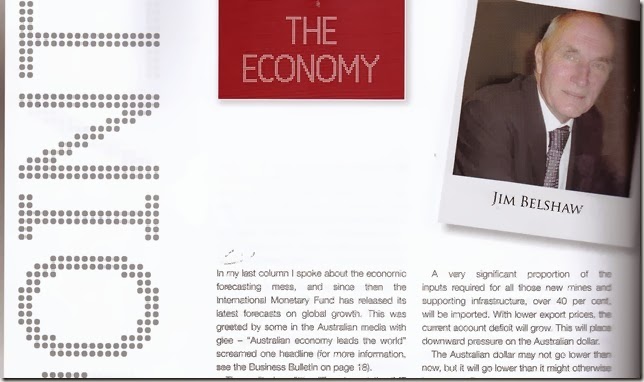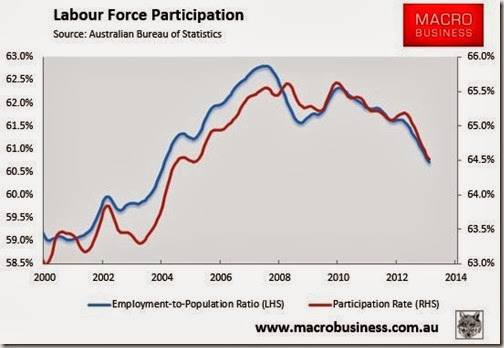
Useful piece by Leith van Onselen in Macro Business, Australian unemployment in detail. Triggered by the latest Australian labour force data, it looks
As an aside, I find the free Macro Business daily economic email briefings very helpful.
This first chart shows total Australian employment. You can see the rise in total employment, its peak, plateau and then slight decline.
The Australian population has continued to increase. Unemployment has been edging up, but not by as much as you might expect.
The reason for this shown in the next chart, the changing workforce participation rate.
From 2000, the participation rate ros e steadily, quite remarkably in fact for such a relatively short period. More people working helped drive Government tax revenues, as did increasing company tax collections.
e steadily, quite remarkably in fact for such a relatively short period. More people working helped drive Government tax revenues, as did increasing company tax collections.
The participation rate then dipped sharply. The decline began before the full global financial crisis hit, but was connected to it. The rate then rose, if to a lower peak, before declining significantly.
This was the period of the two speed Australian economy. As the mining sector boomed, the high value of the Australian dollar slowed growth or even forced contraction elsewhere. This, combined with progressive public sector cuts, led to people dropping out of the workforce. Economists call this the discouraged worker effect. After a certain period of unemployment, people give up and stop looking for work.
Note, however, that the labour force participation rate is still well above the 2000 level. It's helpful to remember that because some economists are now suggesting that declining workforce participation rates have created a choke point limiting Australia's return to trend growth. There may be a choke point, I don't think that there is, but it's more the participation rate is still high by historic standards. This means that there are proportionately fewer workers to draw back into the workforce.
Other factors come into play as well.
The next graph compares growth in full time as compared to part time worker since 1991.
Growth rates for both categories display wild swings. The start of the period is Mr Keating's recession. This was the period of restructuring and process re-engineering as firms shed full time long term employees. These were, in part, replaced by part time workers. Then came a period of sustained growth in full time employment as business improved and firms corrected previous employment errors. Growth in part time employment dived, then rose sharply as new workers were added to meet immediate needs.
Over the whole period, growth in part time workers generally fluctuated more than full time workers. Part time workers are generally easier to add or get rid of. They are economic buffers. However, over the whole period, part time work on average grew father than full time work. The effect of this is illustrated in the next graph.
The fourth chart shows the decline of full time employment as a proportion of total employment. The tile is actually a little misleading. Not all part time workers are casual, nor full time 
What is true, I think, is that an increasing proportion of full time workers are on often shorter term term contacts, while part time workers are, on the whole, more likely to be in casual work. I commented on the impact of this trend in an earlier post here, Friday Economics- economic outlook 2014:
While workforce flexibility does aid business activity, the growing proportion of the Australian workforce working in contract or casual roles has affected consumer behaviour. Greater work uncertainty requires people to hold larger cash reserves, as do the periodic employment gaps often associated with such work. It also depresses Christmas sales, since a not insignificant proportion of the workforce is now only paid when they work. Christmas is actually a low income period for many people.
A few weeks back, I assisted in interviewing for a short term contract position. It was a relatively low level project officer role. All the applicants were over-qualified for the role, some had been out of work for twelve months. Every candidate we interviewed was considered as suitable for the position.
This was not a job in a high prestige area. In the past, it has struggled to get suitable applicants. Now, looking at the applicants from my own experience, I thought that if I could put them together in a single unit, I would have a very powerful multi-skilled team.
The point here is that, unlike some of my economist colleagues,I do not think that the present state of the Australian labour market creates a significant short term constraint on growth at trend or above. There are specific choke points, but there is also plenty of immediate scope for increasing hours worked or to bring skilled people back into jobs.

